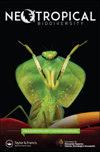Plant community associations with morpho-topographic, geological and land use attributes in a semi-deciduous tropical forest of the Dominican Republic
IF 0.8
Q4 ECOLOGY
引用次数: 1
Abstract
ABSTRACT Despite being increasingly threatened by human-induced disturbances, dry forests remain the least studied and protected forest types in the Caribbean region. In contrast to many other forest systems in the world, we have little knowledge of the site-specific variation in vegetation communities within these forests nor understand how plant species distribution is determined by environmental variables, including geological attributes. Here, we aimed to provide evidence of the relationship between biodiversity and geodiversity, by assessing the associations between plant communities and habitat types in a semi-deciduous forest of the Dominican Republic. We collected vegetation data from 23 sites within the Ocoa river basin, which we classified into six groups with a Random Forest algorithm, using lithology, geomorphology, topography, and last decade history of forest loss as predictor variables. We established three main clusters: one group, which encompassed sites with forest over a limestone substrate, four groups of sites with forests over a marlstone substrate with varying degrees of steepness and forest loss history, and one group that gathered all sites with forest over an alluvial substrate. In order to measure the associations of plant communities with groups of sites, we used the indicator value index (IndVal), which indicates whether a plant species is found in one or multiple-habitat types and the phi coefficient of association, which measures species preferences for habitats. We found that 16 species of woody plants are significantly associated with groups of sites by means of their indices. Our findings suggest that the detection of plant species associations with our selection of environmental variables is possible using a combination of indices. We show that there is considerable variation in plant community composition within the semi-deciduous forest studied and suggest that conservation planning should focus on protection of this variation, while considering the significance and variability of geodiversity as well. In addition, we propose that our indicator groups facilitate vegetation mapping in nearby dry forests, where it is difficult to conduct thorough vegetation or environmental surveys. In short, our analyses hold potential for the development of site-specific management and protection measures for threatened semi-deciduous forests in the Caribbean.多米尼加共和国半落叶热带森林植物群落与形态、地形、地质和土地利用属性的关联
尽管受到人为干扰的威胁日益严重,但干林仍然是加勒比地区研究和保护最少的森林类型。与世界上许多其他森林系统相比,我们对这些森林中植被群落的特定地点变化知之甚少,也不了解包括地质属性在内的环境变量如何决定植物物种分布。本文通过对多米尼加共和国半落叶森林植物群落与生境类型之间关系的研究,为生物多样性与地理多样性之间的关系提供证据。我们收集了奥科阿河流域23个地点的植被数据,并使用随机森林算法将其分为6组,使用岩性、地貌、地形和近十年森林损失历史作为预测变量。我们建立了三个主要的集群:一组包含石灰岩基质上的森林遗址,四组具有不同程度陡峭和森林损失历史的泥灰岩基质上的森林遗址,一组收集了冲积基质上所有森林遗址。为了衡量植物群落与类群的关联,我们使用指示值指数(indicator value index, IndVal)和关联系数(phi coefficient of association)来衡量物种对生境的偏好。结果表明,16种木本植物与样地群具有显著的相关性。我们的研究结果表明,植物物种的检测与我们选择的环境变量是可能使用组合指数。研究结果表明,所研究的半落叶森林内植物群落组成存在较大的变化,并建议保护规划应注重保护这种变化,同时考虑地质多样性的重要性和变异性。此外,我们建议,我们的指标组有助于附近干旱森林的植被测绘,在那里很难进行彻底的植被或环境调查。简而言之,我们的分析具有为加勒比地区受威胁的半落叶森林制定特定地点管理和保护措施的潜力。
本文章由计算机程序翻译,如有差异,请以英文原文为准。
求助全文
约1分钟内获得全文
求助全文
来源期刊

Neotropical Biodiversity
Environmental Science-Ecology
CiteScore
1.80
自引率
0.00%
发文量
39
审稿时长
24 weeks
 求助内容:
求助内容: 应助结果提醒方式:
应助结果提醒方式:


